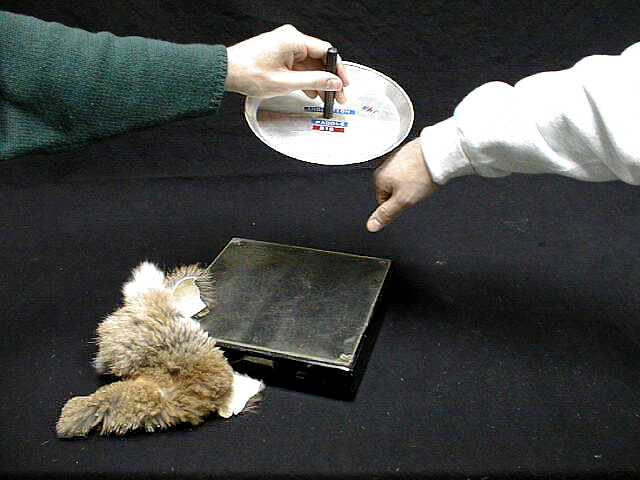
Producing Static Charge: Electrostatics
Electrophorus (Induction Paddle)
PIRA Class: 5A10.20

Producing Static Charge: Electrostatics
Electrophorus (Induction Paddle)
PIRA Class: 5A10.20
 Purpose
Purpose
To demonstrate charging by induction.
Description
Remove, by finger touch, excess charge from a metal paddle that is in contact with a
statically charged acrylic sheet.
1. Rub insulating stand's acrylic sheet with rabbit fur. (Acrylic sheet becomes negatively
charged. This static charge does not move around or off of plate during demonstration due
to the insulating nature of the acrylic. On humid days, the negative charge will
"leak off" of acrylic sooner than desired.)
2. Holding metal paddle with its insulating handle, place paddle in good contact with
acrylic sheet. (Acrylic's negative charge repels metal paddles electrons to the top of the
paddle. Metal paddle will still have a overall net neutral charge.)
3. Touch the top of the metal plate with finger. (Negative charge, electrons, will move
off of plate on to you, the ground. Plate is left with a net positive charge, a deficit of
electrons.)
4. Remove finger, remove the now positively charged plate.
5. Optional: to have students "observe" the net charge on the paddle:
- bring paddle in proximity of/ or in contact with an electroscope
- bring paddle in proximity of/ or in contact with a student's hand
6. The metal paddle can be recharge multiple times without "rerubbing" acrylic
sheet. The acrylic sheet's static charge is not removed by this procedure.
NOTE: If irregularities are observed in the interactions of the charged objects, it is
recommended that all synthetic, including black carts, materials involved be rinsed off
with water or wiped down with a wet cloth.
Web Simulation:
Charging an Electrophorus by Induction Using a Negatively-Charged Object
http://www.physicsclassroom.com/mmedia/estatics/epn.cfm
Equipment
Induction Paddle, Insulating Stand w/ acrylic top sheet, Rabbit Fur